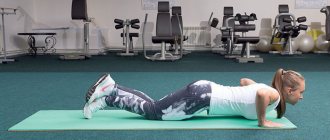The Tracy Anderson Method: Dance Cardio Workout is an aerobic program from the mega-successful celebrity trainer. Get ready to start your fight against excess weight with an intense workout accompanied by rousing music.
Cardio training program in the gym for a week
Exercise bike or bicycle ergometer
An excellent way to do cardio in the gym for those people who suffer from excess weight, pain in the knee joints and spine.
Such machines will provide an effective fat-burning workout without performing a shock load. Taking into account your age and weight, the simulator will determine your heart rate zones. In this case, the training should take place in the fat burning zone or aerobic mode.
First level
- Day 1. Interval load mode - 30 minutes. Before using the simulator, set your personal parameters - gender, age, weight. Heart rate sensors will read and monitor your heart rate to ensure proper exercise.
- Day 2: Pedal at a constant pace for 30 minutes. Maintain a constant fast pace in the heart rate zone, not exceeding the upper acceptable limit.
- Day 3. Resistance pedaling – 40 minutes. Perform slow rotations with force.
Advanced level
- Day 1. Interval exercise in the heart rate zone for fat burning – 45-60 minutes.
- Day 2. Load with resistance at a constant pace - 45-60 minutes.
- Day 3. Pedaling with resistance at a constant pace with a pulse not exceeding the upper limit of the heart rate zone.
Read more about training on an exercise bike →
Treadmill
The most popular and no less effective way to lose weight. You can only train on a treadmill if you have a healthy musculoskeletal system.
Problems with the spine and joints are contraindications for running; in this case, you can practice walking at an incline. Speed modes on the track are changed manually.
First level
Day 1
- Walking 5 km/h – 5 minutes.
- Walking at an incline of 7% (5 km/h) - 5 minutes.
Alternate the bends, performing 4-5 circles.
Day 2
Warm up 5 minutes – walk 5 km/h.
- Running at a speed of 8 km/h – 2 minutes.
- Walking 5 km/h – 2 minutes.
Perform 10 cycles.
Day 3
Walking 5-6 km/h at an incline of 10% for 50-60 minutes.
Advanced level
Day 1
- Walking 5 km/h to warm up – 5 minutes.
- Jogging at a speed of 7 km/h – 5 minutes.
- Walking 5 km/h – 2 minutes.
- Running 8 km/h – 5 minutes.
- Walking 5 km/h – 2 minutes.
- Running 9 km/h – 5 minutes.
- Walking 5 km/h – 2 minutes.
- Jogging at a speed of 8 km/h – 5 minutes.
- Walking 5 km/h – 2 minutes.
- Running 7 km/h – 5 minutes.
- Walking 5 km/h – 2 minutes.
Day 2
Warm up - walking 5 km/h for 5 minutes.
- Running 9-10 km/h – 4 minutes.
- Walking 6 km/h – 1 minute.
Perform 8-10 cycles.
Day 3
Warm-up – 5-7 minutes.
- Running 10 km/h – 5 minutes.
- Walking at an incline of 10% at a speed of 7 km/h – 5 minutes.
Perform 5-6 cycles.
Stepper
With the help of a stepper you can not only lose weight, but what is important for girls, work out the gluteal muscles if you walk with emphasis on your forearms. Alternate walking up the steps vertically and with an incline:
- in the first case, perform acceleration,
- and when bending, set a strong resistance, at which the heels will literally “push” the steps.
Day 1
Perform the workout at the same pace, without exceeding the upper limit of your heart rate - 40-50 minutes.
Day 2
Walk with resistance on your forearms for 40-50 minutes.
Day 3
Interval load mode with setting personal parameters:
- Walking at a fast pace is performed while standing.
- Perform resistance with a load on your forearms.
Training duration is 50-60 minutes.
Orbitrek
By simulating skiing, the elliptical trainer will engage not only the leg muscles, but also the shoulder girdle and torso. This is also a safe and effective method of non-impact loading, which allows you to train at any age and with any body weight.
Day 1
Interval mode, taking into account individual parameters set in the simulator program - 45-60 minutes.
Day 2
Rotate the pedals in the opposite direction, without exceeding the upper limit of the heart rate - 40-60 minutes.
Day 3
- Pedal rotation in the zone 120-160 beats/min – 4 minutes.
- Jump rope - 1 minute.
Perform 8-10 cycles.
Pros and cons of the program
Pros:
1. As with any aerobic training, you exercise at an increased heart rate, which means you spend a large amount of energy, which is drawn from fat .
2. The class is held at a very energetic pace, you will not be bored with Tracy Anderson.
3. With such an intense workout, you increase endurance and improve the functioning of the cardiovascular system.
4. The program improves your plasticity, flexibility and sense of rhythm.
5. Dance cardio training with Tracy Anderson is very positive, accompanied by high-quality moving music. A good mood after such fitness is guaranteed.
6. Before the class, you will find a training course, where Tracy explains in detail all the dance movements that she uses in the program.
7. Many instructors offer aerobic training, but there are not many dance options among them.
Hip-Hop Tabata (Hip-Hop Tabata)
While hip-hop dancing may seem challenging at first, you have nothing to fear. Hip Hop Tabata is broken down into individual movements where you are completely focused on different muscle groups . Dance music will accompany you during the exercise, and once you have mastered the technique of the movement , it can be incorporated into simple choreography . Hip-hop tabata is basically an aerobic exercise that strengthens and tones the body through a variety of choreographed dance moves. It's a fun, intense workout that will leave you sweating profusely . [8]
Benefits of Hip Hop Tabata:
Every intense workout increases your heart rate and has aerobic benefits . Hip Hop Tabata is an intense workout because you have to move all the time. All this time, your body receives oxygen, transports it to the muscles and in the process fat burning . Hip-hop tabata will help you lose weight, reduce blood pressure and stress, and also give your body a lot of energy . Executing each movement correctly and accurately will also help tone your muscles, strengthen them, and even increase the flexibility of your joints and bones. [9]
What muscle groups are involved:
Since hip-hop tabata is an intense workout, it will work the muscles of the entire body . However, you can also split up your workout choreography depending on which muscles you want to target. The abs, buttocks or legs will work the most.
https://youtu.be/3kSkwJSKzog
How to breathe correctly during exercise?
Three basic rules for ideal breathing:
- deep breathing (that is, you need to breathe deeply, and not in small jerks)
- even breathing (even, deep inhalation – even, deep exhalation)
- inhale through the nose, exhale through the mouth
Cardio training
The most striking example of card training is running. It is running that we will consider. When running, complete harmony of the whole body is important: movement - rhythm - breathing rate (especially for long runs). The rhythm of 2:2 and 3:3 (depending on running speed) is considered a classic of the genre.
Explanations:
2:2 is - during two steps you inhale: during two steps you exhale (the same with 3:3, three steps - inhale, three steps - exhale).
As practice shows, this scheme is suitable for 90% of people. For the rest, 10% of people, you need to select the breathing rhythm individually (that is, they themselves must determine how best to breathe).
Power training
The most important rule in strength training is: “during maximum load, exhale; during minimum load, inhale.”
For example: in a bench press, when you lower the barbell to your chest, you inhale, and when you press the barbell from your chest, you exhale.
Why do you need to keep this particular rhythm? Because:
While inhaling:
- maximum muscle stretch
- maximum muscle relaxation
During exhalation:
- maximum strength
- maximum muscle tension
- maximum muscle grouping
That is why such a rhythm is considered the best in terms of physical development and healing.
We looked at how to breathe correctly during cardio training (running) and during strength training
. I also forgot to mention about holding your breath. It is highly not recommended to hold your breath while performing the exercise, as this can lead to dire consequences. Due to a lack of oxygen, the following problems may occur: weakness, dizziness, loss of consciousness, nausea, heart problems in the future. So, breathe correctly, and you will be happy!
Sincerely,
In this article we will talk about the correct, from our point of view, cardio training. As you may have guessed, the prefix “cardio” means that today we will talk about the most important muscle of our body - the heart, as well as blood vessels. The fact is that our heart is the same muscle as, say, the biceps. Why then can’t it be pumped up and trained? Of course you can! And even necessary!
In the gym you always use terms like “leg day”, “back day”, “chest day”, etc. So, we advise you to include a “heart day” in your training program. You'll like this one. We have tested it in practice - it will put you in a state of euphoria, provide you with a surge of strength and energy, improve your metabolism and stabilize your blood pressure! Let's figure out what it is and what it is eaten with.
Belly dance
Belly dancing originates from the Middle East and has a long history. It was used to entertain monarchs, and women who belly danced were considered extremely attractive. The technique of individual movements is really difficult, and thanks to them the dancers have strong muscles . fitness training these days . Belly dancing is a low-risk that makes it suitable for all age groups of women. [11] [12]
Benefits of belly dance exercises:
- improves posture - due to the constant twisting of the hips, pelvis and back, there is an increased secretion of synovial fluid between the vertebrae, which is actually the body's natural lubrication. Thanks to this, bones and muscles do not wear out. Because belly dancing constantly works the muscles during movements, they become stronger and thus improve back health and posture.
- is good cardio - Belly dancing is also a great cardio workout that can burn up to 350 calories per hour, depending on the intensity and weight of the person. Regular blood flow helps reduce cardiovascular problems and, when combined with proper nutrition, can be a fantastic weight loss aid.
- helps you relax - belly dancing can have a meditative effect, especially if it uses exciting music. Since the workouts take place in a calm environment with music, your mind will be able to fully relax. [12]
What muscle groups are involved:
Contrary to its name, belly dancing works more muscle groups, not just the stomach. Basic movements work the muscles of the back, pelvis, abdomen, neck, legs, arms and hands.
https://youtu.be/-34ZqBT55q0
Cardio training to burn fat
The mechanism for getting rid of fat deposits starts after the depletion of glycogen, the carbohydrate stored by the muscles. This can be achieved by doing cardio for at least forty-five minutes or immediately after completing core strength training.
The role of sport in the process of losing weight should not be overestimated. Eliminating junk food from your diet and reducing your overall calorie intake to a moderate level brings much more noticeable results. It is easier to avoid an excess of calories than to deal with the consequences of excessive or improper nutrition.
Zumba
Do you love the rhythms of salsa, samba and latin dance? Then Zumba is for you. This is a training phenomenon that has become the most popular dance training in the world. Zumba is a combination of two dance styles - Latin and African. However, most often Zumba is practiced to the rhythms of Latin and modern music.
The great advantage of Zumba is that it can be practiced by both women and men of different ages and physical abilities . If you think you need to be able to dance to do dance workouts, Zumba will convince you otherwise. Zumba is not a demanding movement, but rather a classic bodyweight exercise that you simply do to the beat of the music. There are several different types of Zumba, from aqua Zumba workouts in the water to toning Zumba, which use weights to further burn calories and tone muscles. There is even Zumba for kids. [3]
Benefits of Zumba:
Just 60 minutes of intense Zumba exercise will help you burn an average of 360 calories , which is almost the same as 60 minutes of easy running on a treadmill. Participants in one small study burned an average of about 369 calories during 39 minutes of Zumba . Additionally, another study found that participants significantly improved their aerobic fitness during a 12-week Zumba training program . Zumba is an ideal workout for burning fat, strengthening muscles and improving flexibility . Another significant benefit of Zumba is that during the workout, you alternate between high and low intensity exercises , and this significantly helps increase your heart rate and endurance . This is evidenced by studies in which participants in a 12-week Zumba program experienced significant improvements in heart rate and systolic blood pressure. Another study found that overweight women experienced a decrease in blood pressure and body weight as a result of Zumba. [3] [4] [5]
What areas of the body can be “improved” in Zumba fitness?
Zumba, like most dance exercises, primarily “pumps up” all the muscles of the body . However, with certain movements, the abs work most of all; with squats, jumps and lunges, the legs, as well as the back muscles.
Rules for performing cardio training
- Before starting exercise, you should consult your doctor, especially if you have health problems or are overweight.
- The duration and intensity of the load must be increased gradually, then the body will not have time to get used to it and the weight loss process will not stop (plateau phase).
- Before training, be sure to warm up and stretch after. This will prepare you for the load and speed up recovery after it.
- During exercise, you need to monitor your heart rate using a heart rate monitor, for example. This is important, since a low heart rate will not bring results, and a high one can harm your health.
- Training should be fun. Feeling bad? Stop exercising.
How to exercise to lose weight
Cardio exercises for weight loss are good because they can be done in the gym, on the street or at home, and they are suitable for both beginners and professional athletes.
The benefit of cardio training for many girls is achieving an ideal figure.
To lose weight, you need to do cardio 3-4 times a week for 30-45 minutes. Subcutaneous fat begins to burn only 20 minutes after the start of training, provided that the heart rate is maintained in the range of 60–80% of the maximum permissible heart rate.
subtract your age from 220 beats per minute;
multiply the resulting number by 0.6 - the lower norm; multiply the resulting number by 0.8 - the upper normal heart rate.
For example: 220-37=183;
183*0.6=109.8, rounded to 110 - this is the lower heart rate; 183 * 0.8 = 146.4, round according to the laws of mathematics and get 146 - this is the upper norm. It turns out that a person aged 37 years without any special health problems needs to train within these limits - 110–146 beats per minute.
The average heart rate during training is within 120–130 beats per minute.
The intensity of the exercises and the training time must be gradually increased, as the body gets used to the load and stops burning fat - a plateau effect. To speed up metabolism, it is very advisable to add anaerobic (strength) exercises to aerobic training, then the process of burning calories will continue after the workout.
Cardio exercises can be done at any time of the day: morning, afternoon or evening. It depends on your daily routine and personal preferences.
Cardio training is carried out in a well-ventilated room or outdoors, since oxygen is actively used during exercise.
Preparatory stage
Before starting training, check your heart rate limits. To obtain the most accurate results, you can undergo a computer examination. This will allow you to clarify your blood pressure limit during training. An alternative way to calculate your optimal heart rate is to use the following formula: 220 minus your age. 65% of the indicated value is the lower limit of the heart rate, and 85% is the upper limit.
To monitor heart rate, all modern exercise bikes and treadmills are equipped with special sensors. To take measurements, simply place your hands on the handrails while exercising on the treadmill. To get the most accurate results, you can use auxiliary measurement sensors built into bracelets, watches and other devices.
The role of cardio before and after strength training
A four- to seven-minute cardio warm-up is a great way to prepare your body for the stress ahead. It accelerates blood flow and increases body temperature. The main thing is to monitor your pulse, the frequency of which should be at the level of 130-150 beats/min.
Cardio, performed after the main training, helps rid the stomach and sides of the fat layer and increase muscle definition. The most effective in this regard are circuit and interval cardio training.
Cardio Training: History
As such, the concept of cardio training began to be used in the 1970s by the “father of cardio” Kennef Cooper. It was he who conducted a lot of research in this direction and defined such concepts as lower and upper thresholds. Unfortunately, in those years, even professional strongmen did not use this type of training. But since the early 1980s, the situation has changed dramatically, and this type of training has gained popularity not only among overweight housewives, but also among bodybuilders and professional athletes.
Sorry for the fact that we are now “loading” you with, at first glance, unnecessary information, but after reading the entire article you will understand that there is no way without it.
Cardio and weight loss
The relationship between the calories burned and the calories expended when performing a particular type of cardio, which most people who want to lose weight are looking for for their workouts, preferring running over walking, can cause metabolic disorders. This happens due to the combination of a sharp reduction in diet with exhausting runs.
The number of calories burned by cardio depends more on your average heart rate than on the type of physical activity. The faster the heart beats, the more energy is expended. Energy consumption is also affected by the duration of exercise.











